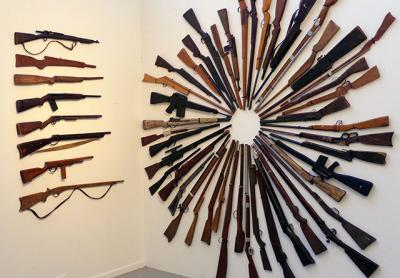East Hampton Collectors At Outsider Art Fair

Outsider Art, for many years the passion of a relatively small group of collectors and scholars, has long since come in from the cold. For the past 25 years it has been featured in such international exhibitions as Documenta, the Carnegie International, and the Venice Biennale and illuminated by countless museum and gallery shows. It has had its own art fair since 1992.
While they may swim in the same commodity stream as the rest of modern and contemporary art, the artworks themselves, created by individuals working outside the context and discourse of the art world, retain a stubborn authenticity and singularity, “unscathed by artistic culture,” as the artist and Art Brut champion Jean Dubuffet put it in 1947.
Of the approximately 60 exhibitors in this year’s Outsider Art Fair, which will open at the Metropolitan Pavilion in Chelsea next Thursday, two, Norman Brosterman and Mark Wilson, are from East Hampton. This is the first fair for Mr. Wilson, who is an artist and co-owner with his wife, Claudja Bicalho, of Lazy Point Variety in Amagansett. Mr. Brosterman, a writer, artist, and curator as well as a collector, is something of a veteran, having had booths in New York many years ago and more recently at several iterations of the fair in Paris.
Mr. Brosterman will be showing large painted baskets of rattan and wire made in the 1930s by inmates at the Anamosa State Penitentiary in Iowa and sold at the prison store. He first saw some of the baskets several years ago at the home of a collector on the North Fork: “About six months ago, I was in Greenport and went to visit this guy, and I convinced him to sell the whole collection.”
The baskets are painted with Native American designs common to the Plains Indians of the Midwest, and Mr. Brosterman’s research confirmed that there were Native American inmates at Anamosa in the 1930s. “Not all of the imagery is authentic,” he said. “It’s somewhere between folk art and Indian art. A lot of the iconography is Sioux, Lakota, and other Plains Indian stuff, but not all of them were made by Native Americans.”
He noted that the baskets, which range in height from 15 to 30 inches, are heavy. “The warp — the major vertical elements — are heavy coated wire. The weft is rattan. As far as I know, no one has ever shown these baskets at an art fair or antiques show.”
While Mr. Wilson has so much material that he plans to rotate the contents of his booth, the centerpiece will be more than 50 life-size, handmade toy wooden guns he purchased from collectors in Pennsylvania and Arizona. “I initially saw one at a big flea market in Massachusetts. I talked to the guy who had it and took his phone number. When I called him in 2016 he said he was ready to sell his collection.” Mr. Wilson assumes the guns were for the most part made by fathers for their children. They are for sale only as a collection.
Among the other curiosities Mr. Wilson plans to draw from are Tantric drawings he found in a suitcase in Jaipur, India; ex-voto or votive paintings from Mexico that were placed in churches to give thanks or seek forgiveness, and inkblot signatures from a 19th-century parlor game called the Ghosts of My Friends. Participants would sign their names with a fountain pen in an entry book and then fold it to create a Rorschach image.
“The psychology and spiritualism that can be seen in the Rorschach signatures is what drives abstraction,” Mr. Wilson said, also citing the work of Hilma af Klint, a spiritualist and mystic who began making nonobjective paintings in 1906 and will be the subject of a solo exhibition in the fall at the Guggenheim Museum in Manhattan.
Mr. Wilson described his booth as a spontaneous social action put together in the last month. “It’s a combination of the psychological, spiritual, traumatic, and insane. But ultimately it is beauty that remains.”
